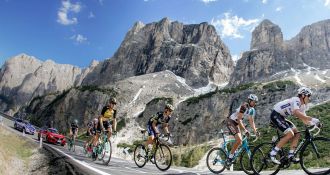

There is a certain peace to be found on the morning of, or the night before, tackling a string of mountain passes by bike. You've done all your training, your bike is ready and raring to go and you've gobbled your last meal. There's nothing more you can do but swing your leg over the top tube after breakfast and head for the clouds. Once you've made it to this point, there are only a few things left to consider; things which the professional peloton make look easy, but which can actually take quite some discipline.
It is right around the time now when amateur cyclists head for the Alps and Pyrenees of southern France and the Dolomites of northern Italy for epic personal challenges on the highest mountain passes in Europe. If you're heading off to one of these hallowed locations this summer, we've got some top tips to optimise your efficiency and enjoyment on the trip of a lifetime.
Climbing
The hardest part? It depends on the sort of rider you are, but most would agree that, at least where the legs are concerned, the ascent is the hardest part of riding the epic cols of Europe. It is certainly the part which takes longest. There are lots of different ways to climb and you'll see them all shown off in the mountain stages of the Grand Tours. In May we saw a stellar exhibition of climbing styles from the attacking sudden accelerations out of the saddle, to the stoic, calm time trial-esque pacing. Unless you're racing, the attacking style of the Quintanas of this world is unnecessary and potentially catastrophic. Amateur cyclists are far better advised to take a leaf out of Tom Dumoulin's book and ride at your own pace in whatever gear feels best to you, trying not to react to what those around you are doing.
Besides technique or method, a key thing to keep on top of when climbing is your food and drink. Some riders find it difficult to consume solid foods when they're putting in the sort of exertion required for ascending, so energy drinks and gels are the best option.
Descending
The first thing you need to consider when you reach the top of a climb is layering up. Pull on a rain cape before taking the obligatory summit photograph and before your body has had a chance to start cooling down. The descent is when you will first feel the sometimes freezing temperature experienced at altitude and the wind resistance makes it even colder. Taking on solid foods is also something you can do at the summit, particularly if this is just the first of many mountains to be taken on in one day.
Most mountain roads in Europe are made up of dozens of lace-like hairpin turns which make climbing easier, but can make descending a little hairy. It is important to bear three things in mind: speed, centre of gravity, and direction of travel. As you approach the switchback with your hands in the drops, you should brake before the turn, get nice and low, push your outside foot down and look at the road ahead. This should ensure your stability and accuracy in descending.
Descending is by its nature fast and nervous, so it is common for riders to find themselves very stiff by the bottom. Try to keep your neck and shoulders nice and loose as you come down and keep the blood pumping by pedalling between corners. This way, you should keep your muscles warm, preventing any strain and making sure you're ready for the next climb.
With this advice, you should now be ready to take on the long mountain passes that so many amateur cyclists aspire to take on. The most important thing is to enjoy it and make sure you do one thing the pros can't… take in the awe-inspiring views of lush green valleys and snow-capped mountains.
Pic - Brakethrough Media